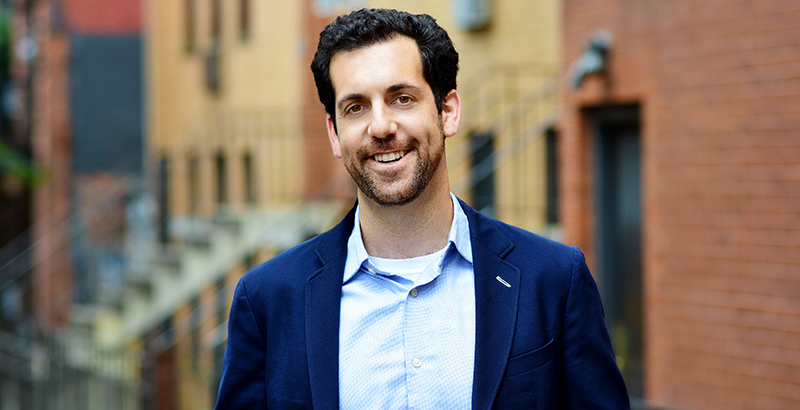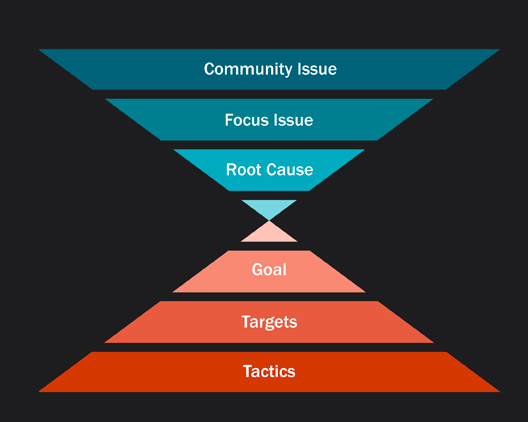How Generation Citizen Uses Action Civics to Empower Students, Grow Lifelong Citizens and Combat Inequality

Scott Warren wants civics to be the most exciting class in school.
That’s why his organization Generation Citizen helps schools adopt action civics, a school-based approach to civics education that empowers students to find a problem in their community and work together to solve it.
Warren started Generation Citizen in 2009 when he was a senior at Brown University and now serves as its CEO, but his interest in what it takes to keep a democracy alive started long before that. He spent most of his childhood traveling the world with his family after his dad got a job in the foreign service.
Generation Citizen “was really started as a way to figure out, how do we get civics back in classrooms, how do we transform and revolutionize the subject, and how do we make it the most exciting class in school?” he said. “How do we see democracy as this vibrant, alive concept that we don’t take for granted but we’re constantly molding and cultivating?”

Warren, who recently published a book about youth political engagement, also sees civics education as a way to combat inequality in the United States. Generation Citizen works mostly with schools where a majority of students are eligible for free or reduced-price lunch, a proxy for poverty, to reach historically disenfranchised groups and close the civic participation gaps.
Countries that have higher levels of engagement tend to have less economic and political inequality, Warren noted, which is why he wants students to learn how to be good citizens early.
“I would argue that, given the extreme stratification and extreme polarity that is occurring right now, this is a necessary reform and shift that needs to occur.”
While growing up, Warren was an eyewitness to major world events like Kenya’s first democratic elections in 2002 and a 2005 coup in Ecuador, which clued him in to what it takes to keep a democracy thriving.
“The citizens in these countries were willing to put everything on the line for democracy,” he said.
When he returned to the United States for college, Warren got involved in local politics, mostly focused on getting his university, the city of Providence and the state of Rhode Island to divest from companies doing business in Sudan because of the conflict in Darfur. He noticed that the young people around him wanted to make the world a better place, but they didn’t believe that local or state government was a good way to effect change.
Youth civic engagement and trust in government hasn’t changed much since then: A 2016 poll revealed that less than half of millennials — ages 18 to 34 — believed that people like themselves “have a legitimate voice in the political process.” There are also disparities in the quality of civics lessons students receive — white, affluent students perform better on civics assessments than their poorer, non-white peers.
Generation Citizen is working to close that education gap and to empower historically disenfranchised students, Warren said. Strong civics education correlates to students being more engaged in political processes, according to the Center for Information and Research on Civic Learning and Engagement, a research center based at Tufts University’s Tisch College of Civic Life.
Generation Citizen expects to reach 30,000 students next year, up from 18,000 this year. The nonprofit is focused on the six states where it has staff — California, Massachusetts, New York, Oklahoma, Rhode Island and Texas — but is also working remotely with educators across the United States and around the world.
Generation Citizen reaches out to school and district leaders in those states directly, but educators can also contact the organization if they are interested in learning more and getting their schools involved. Schools have to pay a fee to partner with Generation Citizen, but the amount depends on location and what they can afford. Warren said that because the organization partners mostly with schools serving low-income students, Generation Citizen tries to find an affordable cost that works for both sides; the organization also receives funding from foundations and corporations.

Intended for middle and high school classrooms, the Generation Citizen curriculum walks students and teachers through the “advocacy hourglass” model, which involves starting with a big idea about a problem in the community, investigating its root causes, identifying ways to solve the problem and working to make those solutions happen. The organization provides the curriculum and training for teachers and pairs some classrooms with college volunteers for added support during the semester-long projects.
For example, Warren cited a group of students in Berkeley, California, who noticed that their local youth homeless shelter was open only part of the year because it lacked funding to stay open longer. The students successfully pressed their city council to give the shelter enough money to stay open year-round. A bill to update HIV education currently winding its way through the Oklahoma statehouse originated in a middle school class working with Generation Citizen.
Abby Kiesa, director of impact at Tufts University’s Center for Information and Research on Civic Learning and Engagement, said the action civics approach builds a sense of agency in young people.
“Part of the action civics model that is particularly notable is that it’s not telling young people what to think, it’s not telling young people specifically what to do, but it’s all about doing that with young people, and it’s all about what they think and care about,” she said. “It centers young people and their experiences … in a way that helps to build efficacy and agency, which is a critical component to ongoing engagement.”
Meredith Norris, executive director of the central Texas division of Generation Citizen, said she realized civics education needed a serious boost when she was working as a middle school social studies teacher in the Bay Area. She talked to students who thought Abraham Lincoln and Martin Luther King Jr. worked together to bring about civil rights, she said.
Generation Citizen is designed to help students learn about their community and cooperate with one another to make it better. Norris said she has seen students lobby their city council to get a sidewalk added near the elementary school their younger siblings attend and watched a class from a rural Texas school lobby their local government to create a youth advisory council.
“What I love about Generation Citizen is it’s allowing students to bring something real from their community into the classroom,” Norris said.
During an action civics semester, teachers are largely working as project managers while their students take ownership of the project, Norris said. Generation Citizen gives teachers professional development before the semester begins so they are prepared to both give students information they might need about how their local government works and be a “guide on the side” who lets students take the lead.
“It definitely is a shift for teachers,” she said. “But once they make that shift, there’s just so much joy and power in that and in seeing what their students are able to do with that individualized coaching support.”
The end goal of Generation Citizen, though, is not sparking one-time community service projects but developing citizens who will stay politically active throughout their lives.
“Our theory of change is all about young people becoming engaged and effective citizens in the long term,” Warren said. “It’s not something that’s going to happen overnight, so we want to convince [students] that they should stay engaged and involved, knowing that the work is going to take a lot of time.”
Get stories like these delivered straight to your inbox. Sign up for The 74 Newsletter

;)
